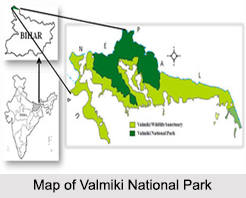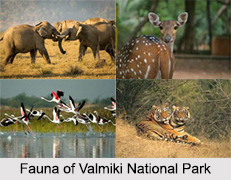 Located in the West Champaran district of the state of Bihar, the Valmiki National Park spreads over an area of almost 336 sq. km. The total forest area occupies 900 sq. km of which about 880 sq. km are covered by the Valmiki Wildife Sanctuary and is thus considered as the first park to house the largest grassland of India.
Located in the West Champaran district of the state of Bihar, the Valmiki National Park spreads over an area of almost 336 sq. km. The total forest area occupies 900 sq. km of which about 880 sq. km are covered by the Valmiki Wildife Sanctuary and is thus considered as the first park to house the largest grassland of India.
This wildlife sanctuary cum tiger reserve is situated on the Indo- Nepal border on the banks of the Gandak River. The Valmiki National Park is also a popular tiger reserve that forms the eastern most limit of the Himalayan Terai forest in the country. As per records of 2018, there are about 40 tigers in the reserve.
History of Valmiki National Park
The forest area of the park was established sometime in the 1900s and was initially owned by the Bettiah Raj, which was known to be the third largest zamindari system in the state. Until the early 1950s, the forest area remained under the control of the Ramanagar Raj. And by 1974, the entire forests were handed over to the Bihar State Forest Development Corporation and on 1978 it was declared as a Wildlife Sanctuary.
The Valmiki National Park was established in the year 1990 and the forests were taken back from the State Forest Development Corporation in 1994. And finally, the Valmiki Tiger Reserve was constituted as the 18th reserve under the Project Tiger of Government of India.
Geography of Valmiki National Park
The landscape of the Valmiki National Park encompasses foothills ranges of the Shivalik Hills covered with dense forests, open woodlands, grasslands, swamps and riverine fringe. The park is situated in bio- geographic zone of the Gangetic plains and together the Valmiki National Park and the Wildlife Sanctuary are parts of a large tiger conservation landscape called the Royal Chitwan Tiger Conservation landscape.
The area surrounding the park is a culturally diverse place as the Valmiki landscape harbours socio- cultural diversity. A scheduled tribe known by the name of Tharu is one of the dominant communities of the area.
 Flora of Valmiki National Park
Flora of Valmiki National Park
There are 7 types of forests that are existent in the Valmiki National Park. These include the Khair or Sissoo Forest, Dry Siwalik Sal Forest, Bhabar or Dun Sal Forest, Open Forest, Moist Mixed Deciduous Forest, Barringtonia Swamp Forest, Eastern Wet Alluvial Grassland, Cane Breaks and many others.
Other than a variety of forests, there are also different types of vegetation found here like the Bahera, Satsal, Karam, Sal, Simal, Asidh, Mandar, Bodera, Bhelwa, Harra and Piyar. The cane breaks which are found scattered in this national park attract tigers and are their natural habitats. They are generally existent in the Madanpur Forest block.
Fauna of Valmiki National Park
Wild Boar, Tiger, Rhinoceros, Leopard, Wild Buffalo, Wild Dog, Black Bear, Blue Bull, Barking Deer, Sambhar, Hog Deer, Antelope, Spotted Deer, Flying Squirrel, Langur, Wild Cat, Monkey, Hyena, etc. are amongst the various mammals of Valmiki National Park. This national park also provides a safe refuge to numerable snakes like Sand Boa, Indian Cobra, Banded Krait, King Cobra, Indian Krait and others.
Visitors will also observe some other aquatic reptiles consisting of Crocodile, Monitor Lizard, and Ghariyal, which are often seen near the Gandak River. It is said that as many as 241 species of birds are existent here and they involve Emerald Dove, Flycatcher, Pied Hornbill, Barbet, Green Wolli, Warbler, Plover, Nepal Kaleej Pheasant, Ibis, Wader, Pitta, Grey Shrike, White Eye, Tree Pipit, Snipe, Stork, Purple Wood Pigeon, Nightjar, Owl and so on.
The Valmiki National Park also possesses innumerable attractive butterflies like the Great Mormon, Club Beak, Lime Butterfly, Great Eggfly, Glassy Tiger, Common Mormon etc.
Visiting Information on Valmiki National Park
The nearest railway station is at Valmiki Nagar about 5 km away from the park and the Patna Airport is the closest at a distance of 295 km from the Valmiki National Park.



















